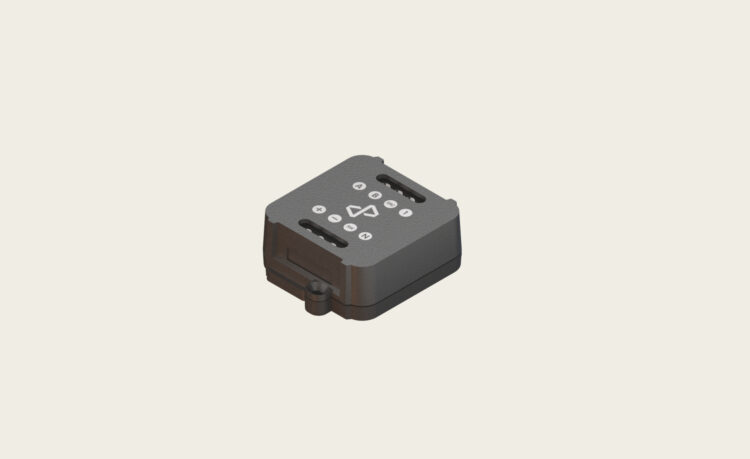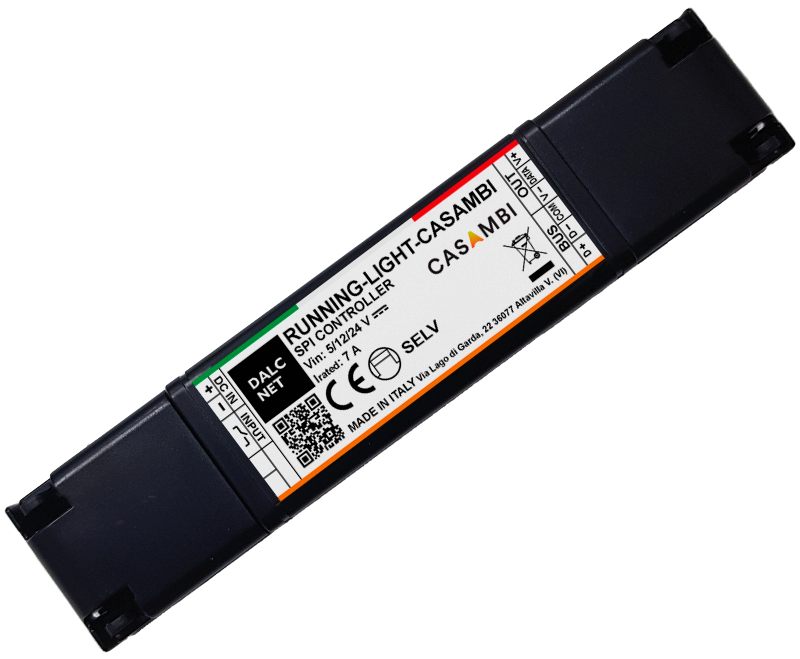PIXEL TO PIXEL- SPI
Discover all categories
- Select a value
-
- Select a value
-
Results
No exact match, try with fewer filters or a more generic term
Digimax: SPI controllers, LED strips, remote controls and software
Digimax offers a complete range of LED Lighting solutions for light control, with particular attention to Pixel to Pixel technology. Thanks to the collaboration with leading companies such as Dalcnet, Colors and Protopixel, we offer latest generation SPI controllers and programmable LED strips, to guarantee maximum flexibility and customization in lighting effects.
Our SPI controllers allow you to precisely manage every single LED of a light strip for scenographic, architectural, advertising and entertainment applications; for a complete service, we offer addressable pixel LED strips for integrated LED lighting systems.
With the support of remote controls, advanced management software and remote light control technologies, Digimax provides cutting-edge devices for professional LED lighting systems, meeting the needs of professional planners, designers and installers.
Digimax products include:
Advanced LED controllers with SPI protocol, compatible with constant voltage power sources and equipped with advanced light management functions;
RGBW+ LED strips and addressable LED modules, designed for Pixel to Pixel control, ideal for scenographic, advertising and architectural applications;
Advanced software and remote controls for simple and intuitive control, which use wireless technologies for quick configuration via smart app.
Advantages of Pixel to Pixel LED Control and Applications
Pixel to Pixel LED technology represents the most advanced solution in the digital lighting sector, offering the possibility of individually managing each LED of a strip or module. This allows you to create unique and original lighting effects: fluid animations, dynamic fades, rainbow effects and custom patterns. The main advantages of these devices include:
Individual LED control and precise adjustment of color, intensity and brightness;
Advanced effects and complex animations, not accessible to traditional LED controllers;
Integration with digital remote lighting management protocols, including DALI;
Easy customization, through dedicated software and mobile applications.
Frequently asked questions about LED controllers with SPI technology
How to control the single pixel of the LED strips?
To control the single pixel of the LED strips, or LED modules, it is necessary to use an SPI (Serial Peripheral Interface) LED controller, which allows you to send specific commands to each LED of the devices. Unlike traditional strips, which change color uniformly, Pixel to Pixel LED strips allow you to set different colors and light intensities for each specific LED.
What is an LED SPI controller and how does it work?
An SPI controller is a device designed to control addressable pixel LED strips, ensuring individual management of the individual LED. It works through the SPI protocol, a serial communication system that transmits digital information to the LEDs of the strip: this allows the creation of dynamic effects, animations, color waves and fluid fades. SPI controllers can be managed via buttons, remote controls, dedicated software or digital protocols (e.g. DALI).
What lighting effects can I create with an SPI controller?
SPI LED controllers allow you to generate a wide range of advanced lighting effects, for example: smooth color transitions along the LED strip, simulation of particular movements, dynamic shades similar to a lit fire, moving color variations with expansions and contractions. Some models even allow you to customize the length, direction and speed of the light effects via smart App, offering entirely customized LED lighting.
What applications can an SPI controller for LED strips have?
The use of SPI controllers for LED strips is ideal for applications with customized and dynamic lighting effects. In the decorative and architectural sector, they are used for scenographic lighting and artistic installations; in the world of entertainment they are widely used for theater shows, concerts and events. Advertising and signage also benefit from it, through illuminated signs and animated displays; finally, the gaming and home entertainment sectors exploit addressable LED strips for immersive lighting effects synchronized with audiovisual content.
What are the differences between a standard LED controller and SPI?
A traditional LED controller manages light uniformly, controlling groups of LEDs simultaneously without advanced customization, offering basic effects such as fading, flashing and synchronized color changes. An SPI LED controller instead allows you to control each LED individually, creating more complex and dynamic effects: if an LED control unit is simpler to use and install, an SPI controller offers greater flexibility and creativity.
What are the differences between LED strips with SPI or PWM?
SPI-compatible LED strips and PWM (Pulse Width Modulation) LED strips differ in how they handle light. The addressable pixel LED strips allow the control of each LED individually, allowing the creation of animated and dynamic effects; on the other hand, LED strips with PWM regulate the light intensity by modulating the voltage, but do not allow individual management of the LEDs, making them more suitable for uniform lighting regulated over the entire strip.
FAQ
Come controllare il singolo pixel delle strip LED?
Per controllare il singolo pixel delle strip LED, o dei moduli LED, è necessario utilizzare un controller LED SPI (Serial Peripheral Interface), che permette di inviare comandi specifici a ciascun LED dei dispositivi. A differenza delle strisce tradizionali, che cambiano colore uniformemente, le strip LED Pixel to Pixel consentono di impostare colori e intensità luminose diverse per ogni specifico LED.
Cos’è un controller SPI LED e come funziona?
Un controller SPI è un dispositivo progettato per controllare strip LED addressable pixel, garantendo la gestione individuale del singolo LED. Funziona attraverso il protocollo SPI, un sistema di comunicazione seriale che trasmette informazioni digitali ai LED della striscia: ciò permette la creazione di effetti dinamici, animazioni, onde di colore e dissolvenze fluide. I controller SPI possono essere gestiti tramite pulsanti, telecomandi, software dedicati o protocolli digitali (es. DALI).
Quali effetti luminosi posso creare con un controller SPI?
I controller LED SPI permettono di generare una vasta gamma di effetti luminosi avanzati, ad esempio: transizioni fluide di colore lungo la striscia LED, simulazione di movimenti particolari, sfumature dinamiche simili ad un fuoco acceso, variazioni di colore in movimento con espansioni e contrazioni. Alcuni modelli permettono persino di personalizzare lunghezza, direzione e velocità degli effetti di luce tramite smart App, offrendo un'illuminazione LED interamente su misura.
Quali applicazioni può avere un controller SPI per strip LED?
L'uso di controller SPI per strip LED è ideale per applicazioni con effetti luminosi personalizzati e dinamici. Nel settore decorativo e architetturale, vengono impiegati per illuminazioni scenografiche e installazioni artistiche; nel mondo dell’intrattenimento sono ampiamente utilizzati per spettacoli teatrali, concerti ed eventi. Anche la pubblicità e la segnaletica ne traggono vantaggio, attraverso insegne luminose e display animati; infine, i settori gaming e home entertainment sfruttano le strip LED indirizzabili per effetti di luce immersivi e sincronizzati con i contenuti audiovisivi.
Quali differenze tra un controller LED standard e SPI?
Un controller LED tradizionale gestisce la luce in maniera uniforme, controllando gruppi di LED contemporaneamente senza personalizzazioni avanzate, offrendo effetti base come dissolvenza, lampeggio e cambio colore sincronizzato. Un controller LED SPI consente invece di controllare ogni LED singolarmente, creando effetti più complessi e dinamici: se una centralina LED è più semplice da usare e installare, un controller SPI offre una maggiore flessibilità e creatività.
Quali differenze tra strip LED con SPI o PWM?
Le strip LED compatibili SPI e le strip LED con PWM (Pulse Width Modulation) differiscono nel modo in cui gestiscono la luce. Le strisce LED addressable pixel permettono il controllo di ciascun LED singolarmente, consentendo la creazione di effetti animati e dinamici; invece, le strip LED con PWM regolano l’intensità luminosa modulando la tensione, ma non permettono la gestione individuale dei LED, risultando più adatte per un’illuminazione uniforme regolata sull’intera striscia.
Cosa fa un controller LED SPI?
Il controller SPI gestisce ogni singolo LED di una strip indirizzabile, permettendo effetti luminosi personalizzati e sincronizzati tramite il protocollo Serial Peripheral Interface.
Come funzionano le strisce LED indirizzabili?
Ogni LED ha un chip integrato che riceve segnali dal controller SPI, permettendo di controllare colore e intensità individualmente, creando effetti dinamici e animazioni.
Come collegare luci LED in serie?
Le luci LED indirizzabili si collegano in serie tramite i cavi dati, alimentazione e massa, rispettando la polarità e seguendo le istruzioni del produttore per garantire comunicazione e alimentazione corrette.


